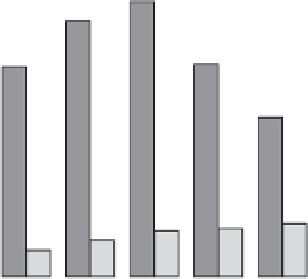Environmental Engineering Reference
In-Depth Information
However, the extracted sediments have to be disposed
of somewhere else. The sediment removal of Lake
Trummen in Sweden is perhaps among the earliest well-
documented work of its kind (Bengtsson
et al.
1975).
Generally, long-term sediment removal results in
good reductions of nuisance algae and aquatic weeds
(Olem & Flock 1990). However, removal of the often
loose, upper sediment layer and its disposal elsewhere
make this technique more expensive than P immobil-
ization within the sediments. Case studies from the UK
(Moss
et al.
1986, Moss 2001) and the Netherlands
(Van der Does
et al.
1992) are examples of only
transient successes: 'The problem is that even if the
sediments are dredged down to the layers that were
laid down even when P was low, there is, after a pause
of a few months, renewed release' (Moss 2001).
the logistics of its transport to lakes are generally
inadequate and expensive, the technique has not
gained popularity in the Netherlands.
12.3.3 Restoration of acidified systems
Reducing emissions
Control actions in Europe, the USA and Canada,
starting around the mid-1970s, when these emissions
peaked, led to a perceptible decrease in annual emis-
sions to the atmosphere of SO
2
and NO
x
by the
mid-1980s (Mason 1996), although NO
x
emissions have
tended to increase, for example in the UK (Fig. 12.7).
Thanks to the national and international clean-air acts
almost all countries committed themselves by 1983 to
reducing sulphur emissions by 30% within a decade,
and many European countries agreed to a reduction
in emissions of 70-80% by 2010 compared with 1980
(UN 1994). However, acidification will continue to be
a problem for many decades in large areas (Henriksen
& Hindar 1993, Brodin 1995a, 1995b). In the acidi-
fied areas of southern Norway, deposition of sulphur
compounds has decreased by about 40% since 1980
but the decrease of nitrogen compounds has not been
Hydrological management: flushing and dilution
with nutrient-poor water
Hydrological management involves replenishing the
lake with water from an extraneous source or from
another lake with lower nutrient levels but preferably
rich in Ca
2+
and HCO
3
−
. Dilution as a restoration tool,
therefore, implies necessarily reducing the nutrient
levels in in-lake water to limiting concentrations
(Cooke
et al.
1993). The success of these measures
depends greatly on the sustained availability of
good-quality water for flushing and the timing of the
flushing: the winter period is the best since both the
dilution water and lake to be diluted have less sus-
pended material. Dilution by flushing has generally
been successfully employed in lakes in the US and
Europe to improve water quality (Cooke
et al.
1993).
In the Netherlands, Lake Veluwe and Lake Dronten
have been diluted since 1979 with relatively P-poor
water, with quite positive results (Hosper 1984,
Hosper & Meyer 1986). Hosper (1998) considered
'washout' by winter flushing to be a powerful man-
agement tool, provided the flushing water is avail-
able in sufficient quantity and is of good quality. He
suggested the winter period (November-February) to
be most effective for wiping out the blooms of fila-
mentous cyanobacteria (
Oscillatoria
spp.), assuming
growth rates of virtually zero in winter. A flushing
rate of > 0.75 lake volumes month
−1
for the 4 months
can remove >95% of the algal bloom. However,
because good-quality dilution water is scarce and
3.2
SO
2
NO
x
2.4
1.6
0.8
0.0
1900
1950
1960
1970
1980
1984
Fig. 12.7
Annual emissions of sulphur and nitrogen
in the UK over more than eight decades starting from
the beginning of the 20th century. Note the decline
in SO
2
emissions starting in the 1970s but a trend
of continuing increase in NO
x
emissions. After
Mason (1996). Reproduced by permission of Pearson
Education, Inc.







